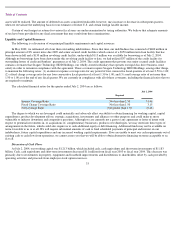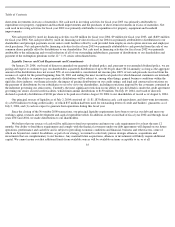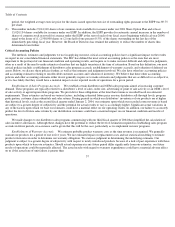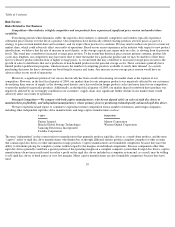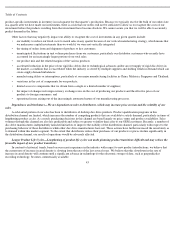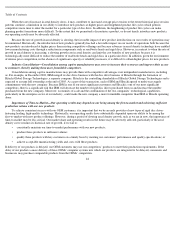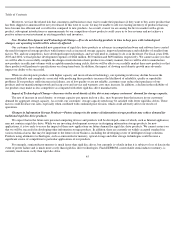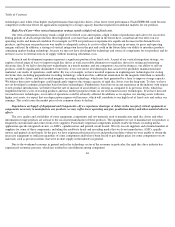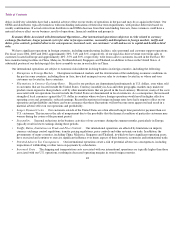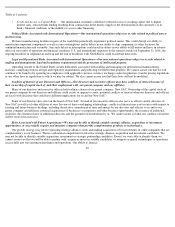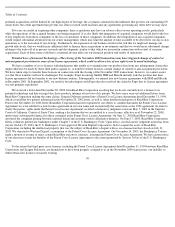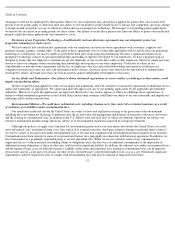Seagate 2003 Annual Report Download - page 44
Download and view the complete annual report
Please find page 44 of the 2003 Seagate annual report below. You can navigate through the pages in the report by either clicking on the pages listed below, or by using the keyword search tool below to find specific information within the annual report.
Table of Contents
product-specific investments in inventory in each quarter for that quarter’s production. Because we typically receive the bulk of our orders late
in a quarter after we have made our investments, there is a risk that our orders will not be sufficient to allow us to recapture the costs of our
investment before the products resulting from that investment have become obsolete. We cannot assure you that we will be able to accurately
predict demand in the future.
Other factors that may negatively impact our ability to recapture the cost of investments in any given quarter include:
•
our inability to reduce our fixed costs to match sales in any quarter because of our vertical manufacturing strategy, which means that
we make more capital investments than we would if we were not vertically integrated;
•
the timing of orders from and shipment of products to key customers;
•
unanticipated fluctuations in unit volume purchases from our customers, particularly our distributor customers who recently have
accounted for an increasingly larger portion of our total sales;
•
our product mix and the related margins of the various products;
•
accelerated reduction in the price of our rigid disc drives due to technological advances and/or an oversupply of rigid disc drives in
the market, a condition that is exacerbated when the industry is served by multiple suppliers and shifting trends in demand which can
create supply demand imbalances;
•
manufacturing delays or interruptions, particularly at our major manufacturing facilities in China, Malaysia, Singapore and Thailand;
•
variations in the cost of components for our products;
•
limited access to components that we obtain from a single or a limited number of suppliers;
•
the impact of changes in foreign currency exchange rates on the cost of producing our products and the effective price of our
products to foreign consumers; and
Dependence on Distributors—We are dependent on sales to distributors, which may increase price erosion and the volatility of our
sales.
•
operational issues arising out of the increasingly automated nature of our manufacturing processes.
A substantial portion of our sales has been to distributors of desktop disc drive products. Product qualification programs in this
distribution channel are limited, which increases the number of competing products that are available to satisfy demand, particularly in times of
lengthening product cycles. As a result, purchasing decisions in this channel are based largely on price, terms and product availability. Sales
volumes through this channel are also less predictable and subject to greater volatility than sales to our OEM customers. Recently, a number of
disc drive manufacturers independently launched initiatives to improve the stability of the distribution channel, particularly with respect to the
purchasing behavior of these distributors while other disc drive manufacturers have not. These actions have further increased the uncertainty as
to demand within this market segment. To the extent that distributors reduce their purchases of our products or prices decline significantly in
the distribution channel, our results of operations would be adversely affected.
Longer Product Life Cycles—Lengthening of product life cycles can make planning product transitions difficult and may reduce the
favorable impact of new product transitions.
In contrast to historical trends, based on our recent experience in the industry with respect to new product introductions, we believe that
the current rate of increase in areal density is slowing from the rate of the last several years. We believe that this slowdown in the rate of
increase in areal density will continue until a significant advance in technology for the electronic storage of data, such as perpendicular
recording technology, becomes commercially available.
43


